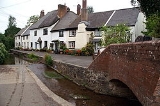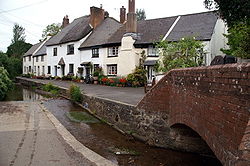
Ide, Devon
Encyclopedia
Ide is a village in Devon
, England
situated less than a mile to the southwest of Exeter
. The village church (rebuilt in 1834) is dedicated to the German Saint Ida of Herzfeld
. The village is home to two pubs: the Poacher's Arms and Huntsman Inn. A long ford (some argue the second longest in Europe) crosses a lane on the edge of the village. Above Ide on a hilltop at SX8888 is the site of a Roman
fortlet or signal station.
 The majority of the village is separated from suburban Exeter by the A30
The majority of the village is separated from suburban Exeter by the A30
dual carriageway. Whilst it was controversial at the time of construction, the road has effectively enabled Ide to maintain an independent identity. However, the parish boundaries extend a short distance over the A30 and several notable buildings within the parish, including Ide House and the Twisted Oak pub, are located on the Exeter side.
Devon
Devon is a large county in southwestern England. The county is sometimes referred to as Devonshire, although the term is rarely used inside the county itself as the county has never been officially "shired", it often indicates a traditional or historical context.The county shares borders with...
, England
England
England is a country that is part of the United Kingdom. It shares land borders with Scotland to the north and Wales to the west; the Irish Sea is to the north west, the Celtic Sea to the south west, with the North Sea to the east and the English Channel to the south separating it from continental...
situated less than a mile to the southwest of Exeter
Exeter
Exeter is a historic city in Devon, England. It lies within the ceremonial county of Devon, of which it is the county town as well as the home of Devon County Council. Currently the administrative area has the status of a non-metropolitan district, and is therefore under the administration of the...
. The village church (rebuilt in 1834) is dedicated to the German Saint Ida of Herzfeld
Ida of Herzfeld
Saint Ida of Herzfeld was the widow of a Saxon duke who devoted her life to the poor following the death of her husband in 811...
. The village is home to two pubs: the Poacher's Arms and Huntsman Inn. A long ford (some argue the second longest in Europe) crosses a lane on the edge of the village. Above Ide on a hilltop at SX8888 is the site of a Roman
Roman Empire
The Roman Empire was the post-Republican period of the ancient Roman civilization, characterised by an autocratic form of government and large territorial holdings in Europe and around the Mediterranean....
fortlet or signal station.

A30 road
The 284 miles A30 road from London to Land's End, historically known as the Great South West Road used to provide the most direct route from London to the south west; more recently the M3 motorway and A303 road performs this function for much of the route and only parts of A30 now retain trunk...
dual carriageway. Whilst it was controversial at the time of construction, the road has effectively enabled Ide to maintain an independent identity. However, the parish boundaries extend a short distance over the A30 and several notable buildings within the parish, including Ide House and the Twisted Oak pub, are located on the Exeter side.

